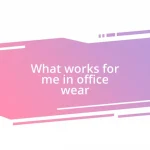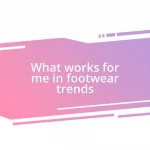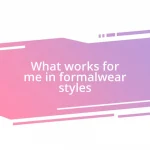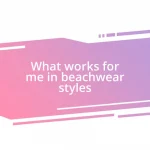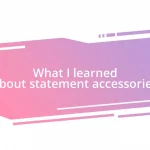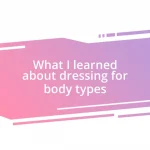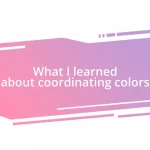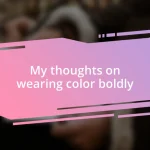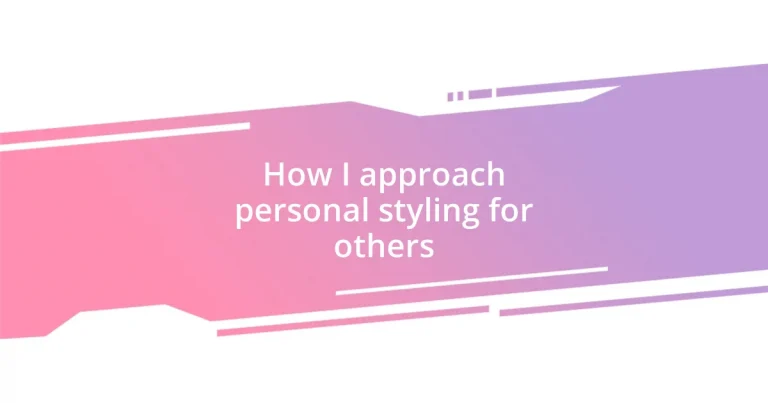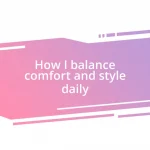Key takeaways:
- Understanding personal styling involves deep conversations to uncover clients’ emotions, personal stories, and aspirations, transforming their wardrobe into a reflection of their true selves.
- Building a personal style profile requires identifying core values, exploring influences, assessing lifestyles, and considering emotional connections to craft a narrative around their style journey.
- Maintaining long-term styling relationships hinges on adapting to clients’ evolving tastes, maintaining open communication, and celebrating their milestones to foster deeper connections.
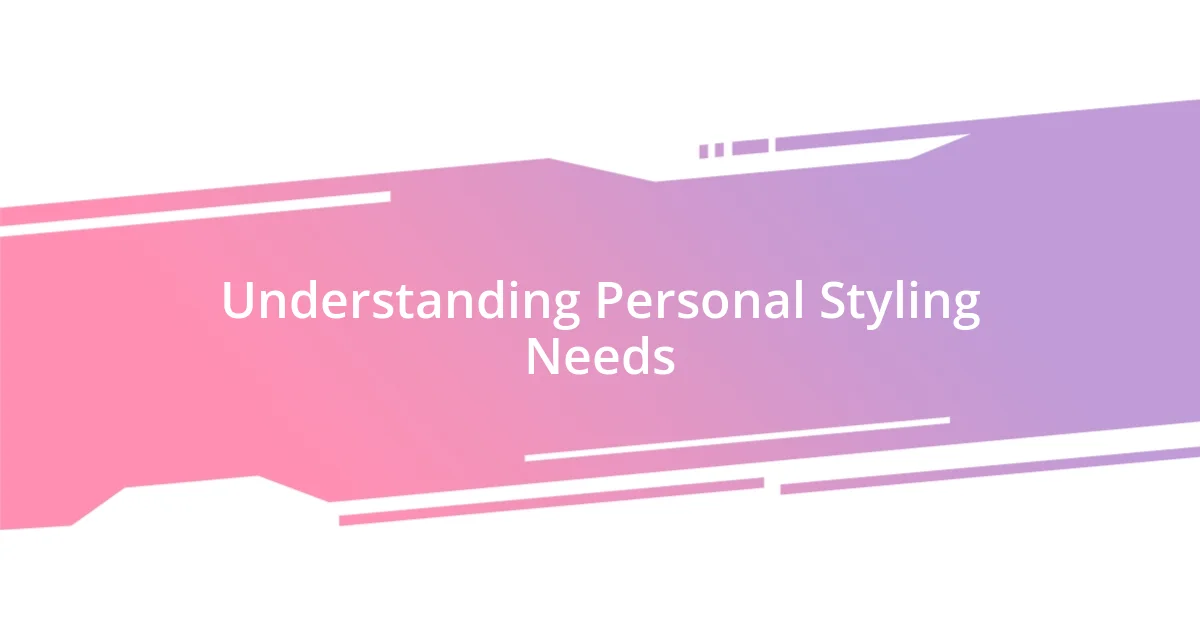
Understanding Personal Styling Needs
Understanding someone’s personal styling needs is like peeling back layers of their personality. When I worked with a client who always wore black, their wardrobe felt limiting at first. Yet, after a few conversations, I discovered that they loved pops of color but feared judgment. It’s amazing how much styling is influenced by personal stories, isn’t it?
I remember a time when a friend struggled to express her vibrant style in a corporate environment. We delved deep into her wardrobe, discussing her aspirations and even her fears about dressing authentically. By the end, she was not only wearing outfits that reflected her true self but also walking into the office with newfound confidence. It made me realize that understanding personal styling needs goes beyond just fabric and fit; it’s about tapping into what makes someone feel empowered.
Have you ever felt misunderstood when trying to express yourself through clothing? I believe that personal style is a unique language, and it takes patience and empathy to truly understand how someone wants to communicate their identity. When I listen to my clients, I’m not just hearing words; I’m feeling their emotions and the weight of their experiences tied to their wardrobe. That connection shapes how I approach their styling needs.
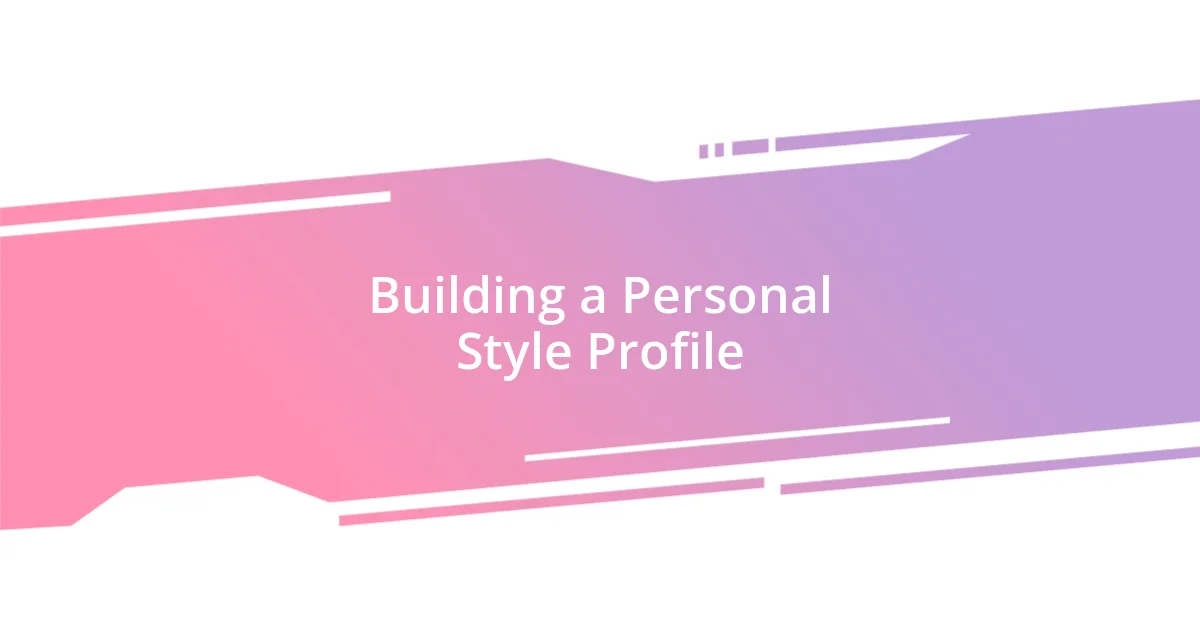
Building a Personal Style Profile
Building a personal style profile starts with deep conversations and insightful questions. I often find that asking about favorite colors and styles can reveal so much more than just preferences; they can uncover personal histories. For instance, while working with a client who loved floral patterns, I learned that her grandmother gifted her a floral dress each birthday, anchoring those designs in cherished memories. I don’t just document preferences; I create a narrative that celebrates their journey.
Here are some effective steps I take to build a personal style profile:
- Identify Core Values: What do my clients value in their lives? This can reflect in their style choices.
- Explore Influences: Who do they admire? Fashion icons or cultural influences can easily inspire decisions.
- Assess Lifestyle Needs: Do they need versatility for a busy daily life, or is their environment more laid-back?
- Consider Emotional Connections: How do certain pieces make them feel? Understanding these emotions is key.
- Create a Visual Mood Board: I often curate images that resonate to visualize their desired style direction together.
These steps often reveal connections I hardly expected, leading to a truly personalized style experience.
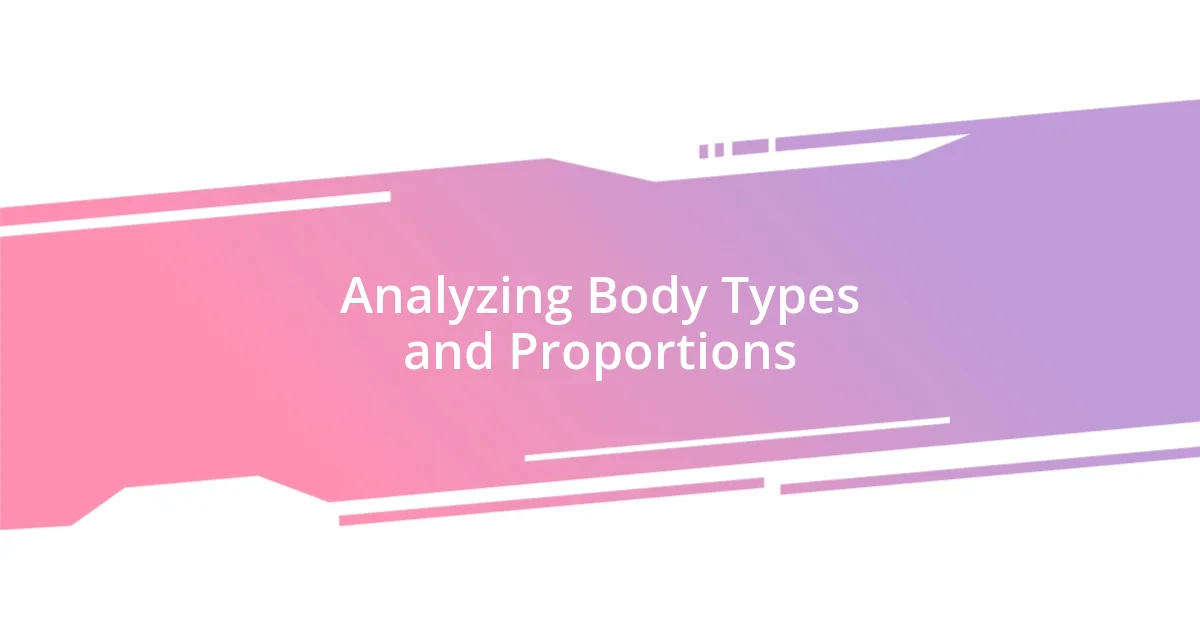
Analyzing Body Types and Proportions
Analyzing body types and proportions is a crucial aspect of personal styling that I take quite seriously. When I first assess a client, I look at their overall shape and proportions to determine what clothing will enhance their natural features. For example, I once worked with someone who had an hourglass figure but was unsure how to dress for their body type. By highlighting their waist and choosing outfits that defined their curves, they not only felt better in their clothes but also gained confidence.
One key takeaway from my experiences is that every body type has its unique strengths, and it’s my job to help clients recognize and embrace those. For instance, a client with a pear shape can benefit from patterns and brighter colors on top, drawing attention upward while balancing proportions. I often ask them how they feel in specific outfits, which leads to meaningful discussions about comfort and style preferences. After all, personal acceptance and body positivity are vital in the styling process.
To help visualize different body types and proportions, I’ve created the following comparison table. This table outlines various body types along with suggested styling choices that tend to flatter each shape:
| Body Type | Styling Suggestions |
|---|---|
| Hourglass | Emphasize the waist, fitted styles, and wrap dresses |
| Pear | Bright colors on top, A-line skirts, and structured blazers |
| Apple | Empire waist tops, flowy fabrics, and straight-leg pants |
| Rectangle | Layering, belts to define waist, and patterns for a dynamic look |
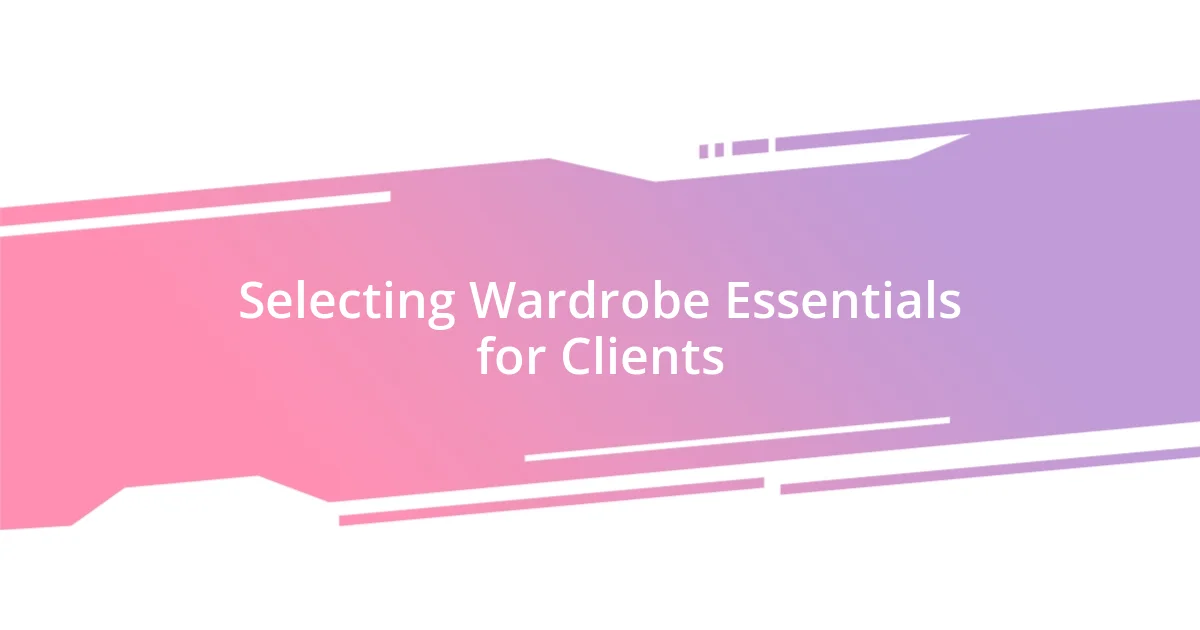
Selecting Wardrobe Essentials for Clients
Selecting wardrobe essentials for clients requires a careful understanding of their individual lifestyles and preferences. I often start by discussing daily activities: Is the client a busy professional who needs versatile pieces, or are they a stay-at-home parent looking for comfort? By aligning my selections with their routines, I can recommend items that serve practical purposes without sacrificing style. For instance, when I worked with a client who was transitioning to remote work, we focused on chic yet comfortable outfits that could be easily adapted for video calls and quick errands.
I find that emotional connections with specific pieces often guide my choices, too. For example, while selecting essentials for a client who had recently become a grandmother, she expressed a strong desire for outfits that wouldn’t feel out of place during family gatherings. This personal touch led us to treasure staples like cozy cardigans and elegant tunics that honored both her new role and her existing style. This emotional insight transforms the selection process into a thoughtful curation rather than just a list of clothing items.
Ultimately, I always remind my clients that their wardrobe should be a reflection of who they are. Are they seeking bold statement pieces to showcase their creativity, or do they prefer a more classic aesthetic? I remember a client who hesitated to choose vibrant colors, fearing they would draw too much attention. Yet, when she eventually ventured to incorporate a lively red blazer into her wardrobe, it not only brightened her outfits but also infused her confidence with a new energy. Wouldn’t you agree that our clothes should empower us rather than limit us?
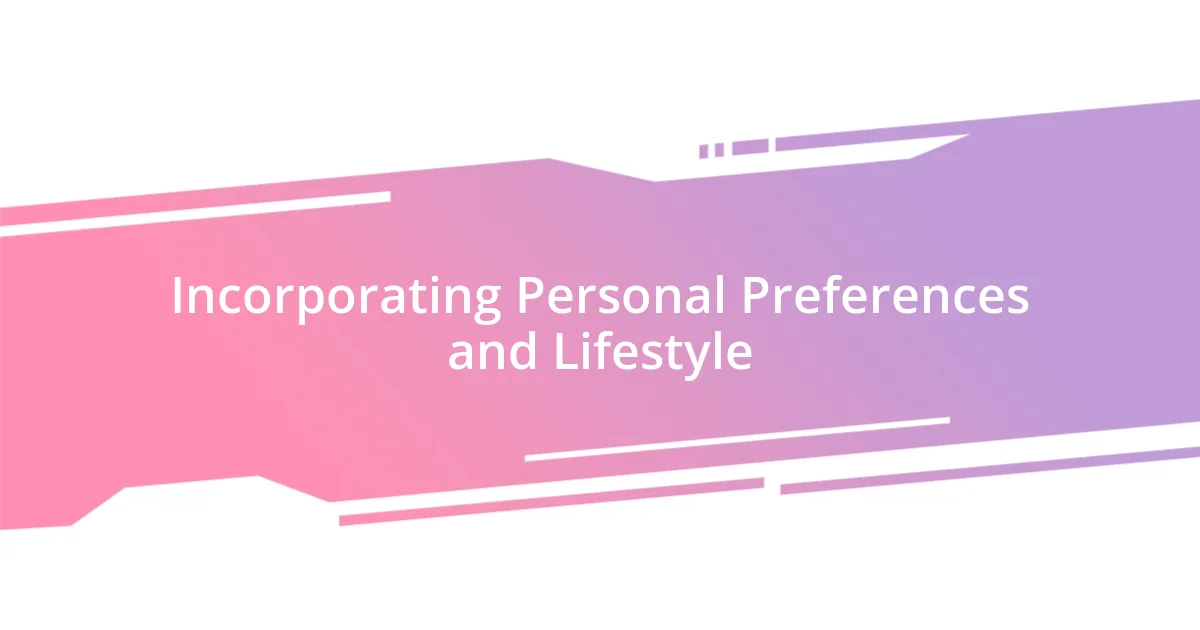
Incorporating Personal Preferences and Lifestyle
Incorporating personal preferences and lifestyle into styling is not just about fabric and fit but connecting on a deeper level. I recall a client who was passionate about sustainability—I found it essential to explore eco-friendly brands that aligned with her values. It became a fun journey, merging her love for the planet with a fresh, trendy wardrobe. This approach not only satisfied her style but also made her feel proud of her choices.
Lifestyle plays a pivotal role too. For example, I once styled a fitness enthusiast who spent most of her time at the gym but wanted outfits that transitioned seamlessly into her social life. By suggesting athleisure pieces that were both functional and chic, we curated looks that she adored wearing, whether she was at a morning yoga class or out with friends. Isn’t it incredible how style can enhance our lifestyle rather than dictate it?
Emotional resonance in personal styling can’t be underestimated. I had a client who loved vintage pieces but often felt out of sync with modern trends. Rather than pushing her toward the latest styles, we incorporated vintage-inspired prints into contemporary designs, allowing her to embrace her love for the past while feeling relevant today. This balance made the process enjoyable—who wouldn’t want to wear clothes that reflect their true self?
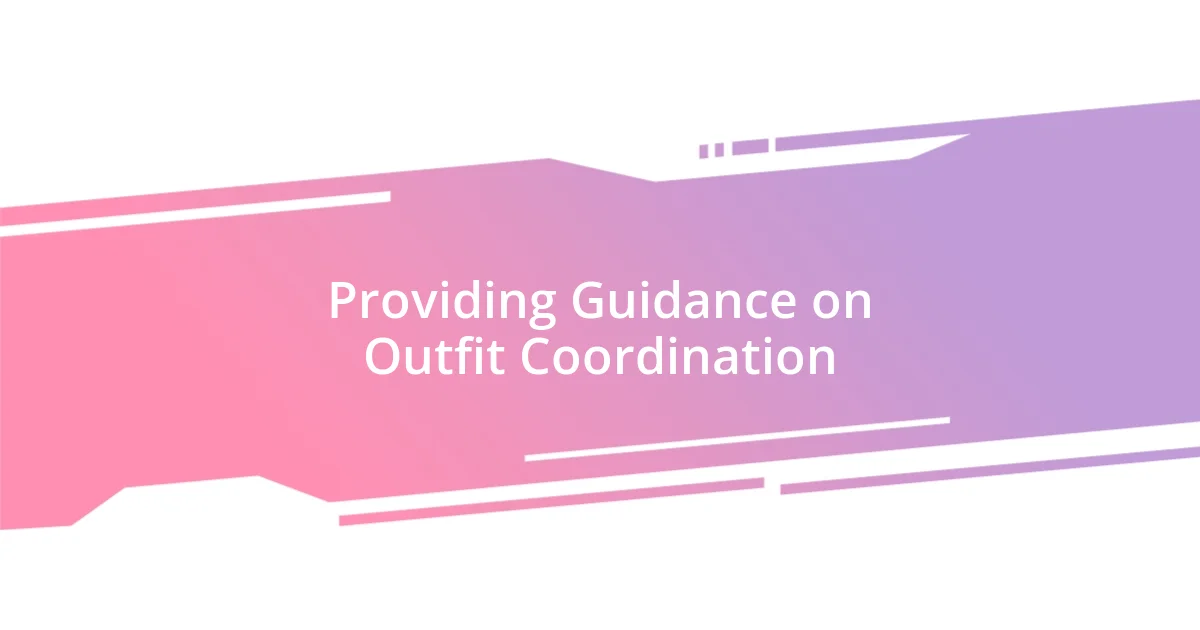
Providing Guidance on Outfit Coordination
Outfit coordination is an art that requires not just an eye for aesthetics but also an understanding of how colors and patterns interact. I vividly remember a client who was unsure about mixing prints. After some discussion, we decided to play with a floral top and striped skirt. To my delight, she found that the contrast not only showcased her playful side but also made her wardrobe feel fresh and adventurous. Isn’t it exhilarating to step out of our comfort zones and explore new styling avenues?
Another key aspect is considering the context in which outfits will be worn. I once styled a client for a wedding and a corporate event happening just a week apart. The challenge was to create pieces that could easily transition from one occasion to the other. By adding statement accessories and using a versatile dress as a base, we successfully crafted a look that was both elegant for the wedding and polished for the professional setting. Have you ever thought about how one foundational piece can significantly alter an outfit’s vibe?
I truly believe that the right outfit can evoke powerful emotions. For instance, I had a client who often wore muted colors, as she felt they were more suitable for professional settings. However, during our session, she stumbled upon a bright mustard sweater that made her light up. It was amazing to see her confidence blossom when she donned that cheerful hue. When have you experienced that instant boost of joy from a cherished piece in your wardrobe? It’s moments like these that remind me how meaningful outfit coordination can be, generating not just style but genuine happiness.
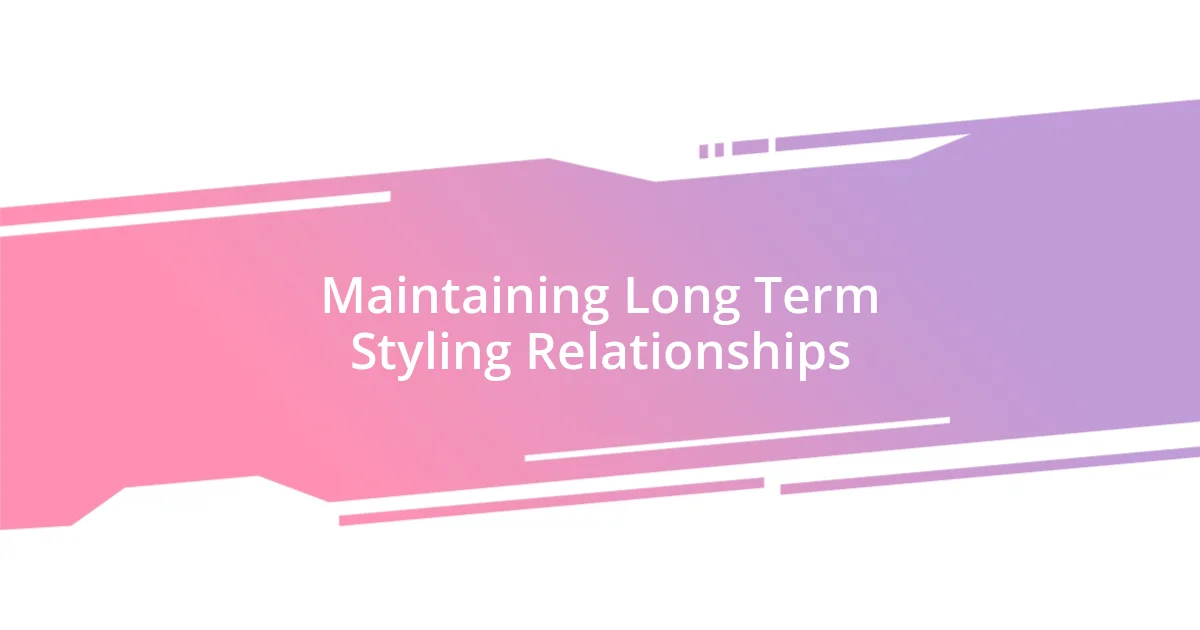
Maintaining Long Term Styling Relationships
Building long-term styling relationships requires genuine investment in understanding each client’s evolving tastes and lifestyle changes. I once worked with a client who started as a busy office worker but gradually shifted into freelance work. Instead of discarding her office wear, we creatively adapted her wardrobe, adding layers and accessories that made each outfit flexible enough for client meetings or casual coffee chats. How powerful is it to see someone effortlessly flow between different parts of their life in their clothing?
Communication plays a crucial role in maintaining these relationships. Regular check-ins, whether through a quick text or a coffee catch-up, can help me stay attuned to my clients’ needs. I remember a client expressing a desire for more adventurous pieces after an extended period of wearing neutrals. By discussing her fashion aspirations, we could brainstorm fresh looks together, infusing her closet with excitement. Isn’t it wonderful when clients feel empowered to voice their desires, knowing they have someone ready to listen?
Lastly, celebrating milestones and accomplishments fosters a deeper bond. I once surprised a long-term client with a beautifully wrapped gift of designer sunglasses to commemorate her promotion. The joy on her face not only solidified our partnership but also reinforced her sense of style as an integral part of her success. After all, isn’t personal styling about so much more than just clothes? It’s about helping individuals feel celebrated in every chapter of their lives.
